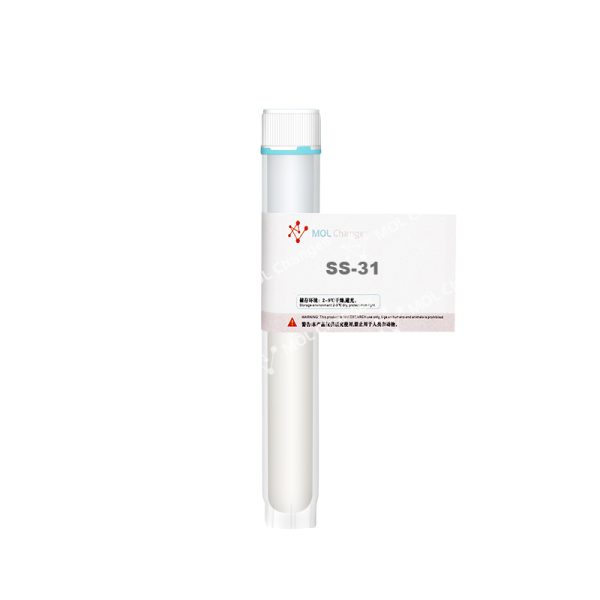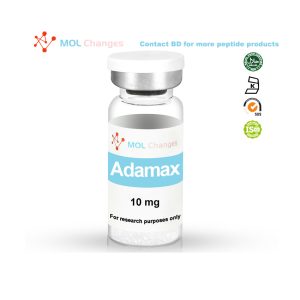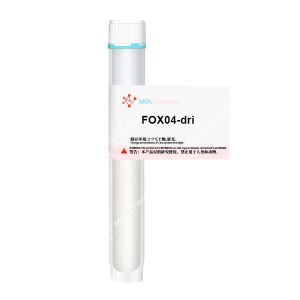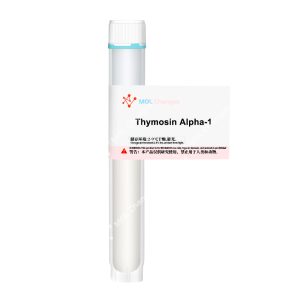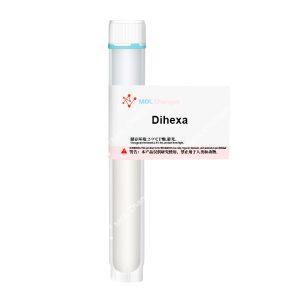SS-31 (elamipretide) is a small aromatic peptide that easily penetrates cell and organelle membranes. It is thought to interfere with the production of reactive oxygen species (ROS or free radicals) and promotes energy production in cells by stabilizing the enzyme cardiolipin in mitochondria. Cardiolipin is part of the inner mitochondrial membrane and is an essential component of the electron transport chain, which is the mechanism that generates most of the energy needed for cellular function.
Cardiolipin dysfunction has been implicated in the pathology of many diseases, including Alzheimer’s disease, Parkinson’s disease, nonalcoholic fatty liver disease, diabetes, heart failure, HIV, cancer, and chronic fatigue syndrome. Cardiolipin is thought to be a major component of mitochondrial myopathy, which is not a single disease but a group of neuromuscular disorders caused by mitochondrial damage. Characteristics of mitochondrial myopathies include muscle weakness, exercise intolerance, heart failure, seizures, and dementia.SS-31 is the first peptide to be clinically tested as a potential treatment for mitochondrial myopathies.
Sequence
D-Arg-Tyr(2,6-diMe)-Lys-Phe
CAS Number
736992-21-5
Molecular Formula
C32H49N9O5
Molecular Weight
639.8 g/mol
Mitochondrial Improvement
Primary Mitochondrial Diseases (PMD) are one of the most common inherited diseases in the world. They are caused by dysfunction of the mitochondrial energy-producing apparatus. Symptoms vary widely between disease forms, but the organ systems most likely to be affected are those with high energy demands (e.g., nervous system, heart, kidneys, etc.). Muscle involvement and exercise intolerance are almost universal in mitochondrial disease. Common symptoms include easy fatigue, exercise intolerance, and seizures.
A key feature of PMD and mitochondrial disease in general is disturbed production of ATP, which serves as the energy currency of the cell and is necessary for almost all cellular functions. Stabilizing ATP production in the context of mitochondrial disease has long been a goal of the medical community. With the development of SS-31, this goal may finally have been realized.
The first evidence that SS-31 can restore energy production in PMD came from animal studies. In that study, mice with renal ischemia-perfusion injury, a non-genetic cause of mitochondrial disease, were injected with SS-31, a peptide that protects renal structures, accelerates the restoration of ATP production, and reduces cell death and necrosis in the kidneys. Subsequent studies in mice have shown that SS-31 interacts with cardiolipin in the inner mitochondrial membrane and suggest that the peptide reduces the symptoms of mitochondrial disease, regardless of the cause. There is also evidence that it may improve mitochondrial dysfunction due to age. From these findings, it was relatively simple to convince the FDA to grant SS-31 orphan drug status and pave the way for clinical trials.
In human phase II trials, SS-31 improved motor performance after only 5 days of treatment and showed no safety concerns or significant side effects [5]. Unfortunately, the Phase III trial failed to provide compelling evidence of SS-31’s clinical utility. That said, there is good reason to believe that the trial endpoints were simply inappropriate and that additional work will result in the peptide being approved for the treatment of certain mitochondrial disorders. Dr. Bruce Cohen, director of the Center for Neurodevelopmental Sciences at Akron Children’s Hospital, said that the results of the previous Phase II clinical trial were very encouraging, so now is not the time to give up. Instead, he notes that SS-31 should spark interest in this particular area and bring other large pharmaceutical studies to the table [7]. This appears to have already happened, as the company that first put SS-31 into clinical trials is planning to move forward with trials of SS-31 derivatives as well as trials investigating other endpoints treated with SS-31.
To date, SS-31 is being tested in a number of different human diseases and under a number of different trial models. The peptide is believed to be safe for use in humans, so physicians can also prescribe it under compassionate care exceptions for patients who have no other treatment options. In the near future, the peptide may become part of mainstream medicine for the treatment of a wide range of diseases, but even now, it is available to those who need it while clinical trial work is underway.
Ischemia
Perhaps the most compelling secondary application of SS-31 is the treatment of heart failure. It has long been known that heart failure leads to negative changes in mitochondrial function, and that these changes cause heart failure to worsen in a destructive cyclical fashion. Studies of human heart tissue treated with SS-31 have shown significant improvements in mitochondrial oxygen flux and the activity of specific components involved in ATP production. However, this particular study was conducted in a manner that excluded cardiolipin reorganization, suggesting that SS-31 may have a second mechanism of action on mitochondrial function that needs to be explored [4]. This finding has actually been replicated in a number of studies, reinforcing the idea that SS-31 not only contributes to the restoration of ATP production through cardiolipin interactions. The peptide’s ability to alter reactive oxygen species production and improve mitochondrial function under acute and long-term use is being actively investigated.
For example, studies in dogs have shown that long-term treatment with SS-31 improves left ventricular function in patients with advanced heart failure. Measures of mitochondrial respiration and maximal ATP synthesis in this study correlated strongly with overall improvement in left ventricular function, implying that SS-31 may be an effective long-term treatment for improving energy dynamics and reducing cardiac remodeling in advanced heart failure.
Trials exploring the use of SS-31 in ST-segment elevation myocardial infarction (heart attack) found that the peptide substantially reduced levels of HtrA2, a measure of cardiomyocyte apoptosis. These results suggest that SS-31 may be useful during an acute heart attack to reduce the extent of damage and protect heart tissue.
Diabetes
Diabetes mellitus, although seemingly caused simply by insufficient insulin secretion or function, is actually a complex disease with multiple pathophysiologic manifestations. In recent years, there has been increasing interest in the role of mitochondrial damage in disease pathogenesis, particularly in type 2 diabetes. Therefore, treating mitochondrial dysfunction would be one way to ameliorate some of the long-term consequences of diabetes, such as oxidative damage to small blood vessels. In a study conducted in humans, a significant reduction in reactive oxygen species production was observed after administration of SS-31. This suggests that SS-31 may help reduce the oxidative damage that typically accompanies mitochondrial dysfunction, and therefore may slow or halt the progression of microvascular disease in type 2 diabetes. This hypothesis is further supported by findings in the same study that SS-31 increased levels of SIRT1, which has been linked to improved insulin sensitivity and reduced inflammation in type 2 diabetes.
Reducing inflammation
The subject of the above sections is inflammation and the ability of SS-31 to reduce it. In particular, SS-31 appears to be a potent regulator of reactive oxygen species (free radicals) and therefore helps to reduce severe oxidative stress caused by long-term diseases such as diabetes and heart disease. Cell culture studies have shown that SS-31 reduces inflammation and oxidative stress by decreasing the expression of FIS1, a mitochondrial protein important for mitochondrial growth and division. Elevated levels of FIS1 have been observed in many neurodegenerative diseases, as well as in a variety of cancers, and have been implicated as evidence of mitochondrial division dysfunction secondary to dysfunction and inflammation.
There is ample evidence from mouse models that SS-31 reduces levels of the inflammatory cytokine CD-36, decreases the expression of activated MnSOD, inhibits NADPH oxidase function, and inhibits NF-kappaB p65. All of these are hallmarks of high oxidative stress, and thus lowering their levels suggests a reduction in free radical production and an improvement in the inflammatory state of cells. In particular, NF-kappaB expression is strongly associated with cellular inflammation and is chronically active in a variety of inflammatory diseases such as rheumatoid arthritis and inflammatory bowel disease. With SS-31, mitochondria do not undergo inflammasome activation, i.e., they do not shift from predominantly ATP production to predominantly ROS production.
COA
HPLC
MS
Article/Literature Citation Notes
The purpose of quoting the scientist and professor's article is to acknowledge, recognise and applaud the exhaustive development work that has been done to undertake this peptide research. The scientist does not in any way support or advocate the purchase, sale or use of this product for any reason, and MOL Changes has no affiliation or relationship, implied or otherwise, with the scientist.
warning
These products are intended for scientific purposes only for in vitro research and are not to be used for human, animal or unethical experiments, in vitro research (Latin: in glass) is conducted in vitro. These products are not drugs and are not approved by the Food and Drug Administration in any country for the prevention, treatment or cure of any medical condition, disease or illness. The introduction of this product into humans or animals in any form is strictly prohibited by law.
Business Policy
MOL Changes does not sell to individuals, but only provides services for scientific research purposes to scientific research institutions, pharmaceutical companies, higher education institutions in the field of biology, cosmetics institutions, and scientific research reagent brands.


